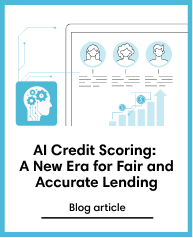Credit Scoring
Apr 9, 2021
How embedded scoring is instrumental for financial institutions
Subscribe to our newsletter
Financial technology or fintech has evidently and significantly evolved over the years―from the invention of lightweight credit cards in the 1950s to the constant usage of e-wallets and mobile banking apps today. While these solutions have been marketed as alternatives to traditional banking products and services, they’ve now proven that they can be replacements as well. Moreover, during the COVID-19 pandemic, where physical interaction is discouraged, fintech solutions have become more important than ever.
Fintech solutions have been so convenient that they have given birth to a new term called embedded finance, wherein non-financial companies equip their tech offerings with financial services to provide their end-users with a complete customer experience. Some of the best examples of embedded finance include ridesharing apps equipped with e-wallets and credit and debit card payment methods and e-commerce brands with integrated payment processing and lending services.
Of course, one can’t exclude embedded finance in the world of lending. Today, traditional credit card companies, lenders, and other financial institutions are kick-starting their digital transformation and employing technology to better gauge potentially good borrowers from neglectful ones. One of the results of their digital transformation is embedded scoring.
What is embedded scoring?
Embedded scoring, stemming from the definition of embedded finance, integrates credit scoring technology to financial services today. As fintech continues to evolve and the demand for such a solution continues to increase every day, there’s now a pressing need for lenders and other similar financial institutions to upgrade their processes and tech as well―and embedded scoring can help with that.
Most, if not all, lenders are now making stricter and more rigorous processes to review credit and loan applications better. Ultimately, these processes slow down the procurement of loans of borrowers, thereby delaying their planned investments. With the help of embedded scoring, lenders can simplify and accelerate their operations while maintaining approval accuracy and helping borrowers attain the loans they need.
Benefits of embedded scoring
First and foremost, embedded scoring provides transparency and security. Any form of technology today has made it possible for companies and even ordinary individuals to enhance their security systems and better protect data. In the context of credit scoring, embedded scoring provides another level of security that lenders need to gauge the creditworthiness of a borrower quickly.
Moreover, embedded scoring enables financial institutions to streamline their work. For example, with all the manual processes now automated and accelerated by technology, loan lending will be easier and more convenient than ever to both the lender and borrower.
In the general context of fintech, embedded scoring provides a more advanced way for people to access financial services and ultimately further elevate fintech towards innovation. Furthermore, by proving that technology works in every aspect of finance, including credit scoring and credit risk management, embedded scoring can contribute to something bigger in fintech today and in the future.
Many fintech companies today are offering embedded scoring services for various applications. Our company CredoLab, for instance, designed its embedded scoring platform to collect and use data and insights from privacy-consented data sources to provide companies with a simple, ready-for-action profitability plan. The solution is currently available for different lenders and other financial institutions, allowing them to scale and secure their services and improve customer satisfaction.
Conclusion
There’s almost no limit to what fintech solutions can do today. While flying cars and holographic phones are still mankind’s dream innovations in the future, we can still say that we’ve progressed, given how much the financial industry has evolved. As financial processes become more difficult to implement and follow, we can only rely on modern fintech solutions to save the day.





